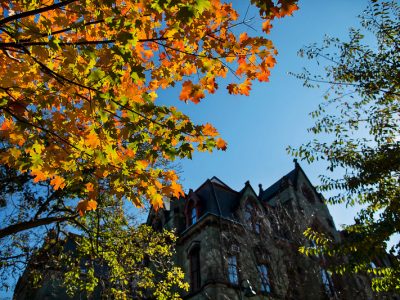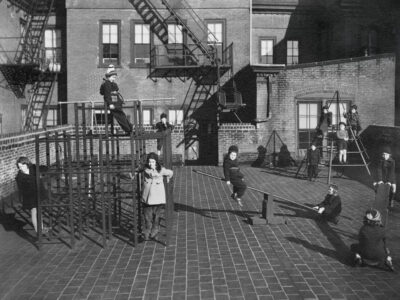THIS SUMMER PENN ANNOUNCED a partnership with the School District of Philadelphia and the Philadelphia Federation of Teachers to create a University-assisted, pre-K-8 public school in the neighborhood — an initiative that drew praise as a bold step toward improving local education and revitalizing West Philadelphia, but also criticism from some community residents who fear that they won’t have enough input or that it may siphon resources from other local schools.
“Nothing is more important to the health and vitality of a community than the quality of its public schools, and that certainly is the case in West Philadelphia,” said Dr. Judith Rodin, CW’66, president of the University, when the plan was announced in June.
“This will be a wonderful opportunity for children in West Philadelphia,” added Dr. David Hornbeck, L’71, Philadelphia’s superintendent of schools. “It will be a vibrant, diverse neighborhood school, and it will join with other schools … in a broad-based, long-term effort to improve the quality of education.”
Scheduled to open by September 2001, the facility will ease overcrowding in other West Philadelphia classrooms and will serve as a “demonstration” school, with a focus on student achievement and professional development for teachers throughout the district. Typically, university demonstration schools, or lab schools, are private. “This is the first lab school that I know of that’s a public school,” says Carol Scheman, Penn’s vice president for government, community, and public affairs. “In this way, I think we’re breaking new ground.”
The school will be built on the University-owned site of the old divinity school, bounded by 42nd, 43rd, Locust, and Spruce streets, which the University will make available to the school district for a nominal cost. Once it opens, Penn will provide up to to $700,000 in annual operating support, or about $1,000 per student, to help reduce class sizes through staff hirings. Although Penn officials hope a University-assisted school will entice more faculty and staff to move to West Philadelphia, they stress that the school’s residence-based enrollment will reflect the economic and racial diversity of the community and will not just serve the children of Penn employees.
Also included in the vision for the new school are plans to provide — in partnership with the community — after-hours services like day care and adult education, along with recreational activities.
In addition, Penn will play a leadership role in the two Cluster Resource Boards that serve West Philadelphia schools by helping to make improvements in programs and facilities. (The district is divided into 22 clusters of elementary, middle, and high schools). Dr. Susan Fuhrmann, dean of the Graduate School of Education, will serve as the primary chair of the West Philadelphia Cluster Resource Board, and Dr. Ira Harkavy, C’70, Gr’79, director of the Center for Community Partnerships at Penn, will serve as the primary chair of the University City Cluster Resource Board.
Penn also has agreed to work with the school district to relocate the overcrowded Carver High School for Engineering and Science to a University-owned site at the southwest corner of 38th and Market streets. The district will be responsible for the construction of a new facility.
“The project is a good example of enlightened self-interest,” praises a Philadelphia Inquirer editorial. “Penn needs West Philadelphia to thrive, to preserve the university’s appeal to students and scholars, and good schools make neighborhoods thrive. And it’s using patient partnering, not bulldozing ahead on its own, to cultivate its garden.”
But at the same time, some community residents attending forums on the issue questioned why they had to read about the partnership in the newspaper before hearing about it from University officials. “I’m not saying the school will be a bad thing,” the Inquirer reported Mark Basnage, a member of the Spruce Hill Association, as saying. “But there has to be some way to recognize the interests and expertise in the community.” For several years the homeowners’ group has been studying how to improve local schools.
Others worry that Penn’s commitment to this project might drain resources from existing public schools, which the University has assisted through its Center for Community Partnerships for the past decade. Still another concern is that enrollment in the new school will change the racial makeup of neighboring elementary schools, which rely on their integrated status for extra government funding.
Scheman says it’s too early to fill in many of the details of the school partnership. “There [was] a lot of concern that there was not enough consultation [before the announcement]. But the only thing that has happened so far is that the University was able to sign a memorandum of understanding with the school district and the teacher’s union to do this. How we do it, and all of the details, have to come later, with a great deal of process and community involvement.”
One point that is already clear is that the University’s commitment to the other West Philadelphia schools will grow, not shrink, Scheman says. “What is currently happening is the base.” An example of Penn’s increasing involvement, she says, is the co-chairing of the cluster resource boards, which will allow Penn to work more closely with the community and teachers in other West Philadelphia schools to better coordinate Penn programs in those schools.
The demonstration school will give Penn’s Graduate School of Education more opportunities to train its students to teach in urban classrooms and to conduct education research, while assisting Philadelphia teachers with curriculum and professional development.
In fact, the new school is expected to provide educational demonstrations for teachers throughout the district. “It’s a benefit not just to a single school, but to all schools in the Philadelphia School District,” Scheman says. As a demonstration school, it will be exempt from the usual hiring and evaluation requirements specified in the teachers’ contract.
The site on which the school will be built currently houses two child-care centers used by many University employees and a private school, leaving many to wonder what will happen to those programs. Scheman says Penn will make sure the child-care services continue. “President Rodin understands clearly the importance of these centers to the Penn community and our external communities.”
Marni Sweet, director of the highly- regarded Parent Infant Center, believes that the University is committed to preserving both programs. However, she says, “I don’t think they’re far enough in their planning to be absolutely sure whether we’ll continue to exist on this block. That’s a matter of some concern, because outdoor play space is terribly important to a day-care center, and this block offers some of the best outdoor play space around.
“We’re very hopeful that there’s a way we can be built into the plan for the new school,” Sweet says. “There are lots of opportunities for a partnership between the school and a child-care center that would be much easier to do if they were all on the same site.”
Thursday, July 3, 2025
Popular
Administration
Anniversary
Archaeology
Architecture
Art
Awards
Books
Calendar
Campus Life
Commencement
Education
Elsewhere
entrepreneurs
Events
Exhibition
Expert Opinion
Faculty
Film
Football
Gifts
Health
Healthcare
Heard on Campus
History
International
Leadership
Medicine
Men's Basketball
Music
notes
obits
painting
Penn Medicine
Penn Museum
Philadelphia
Photography
Poetry
Politics
Science
Student Life
Technology
Television
Theater
Wharton
Window




